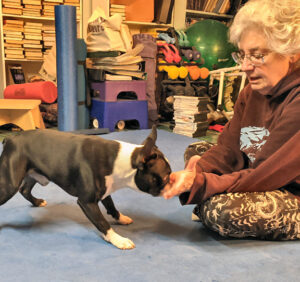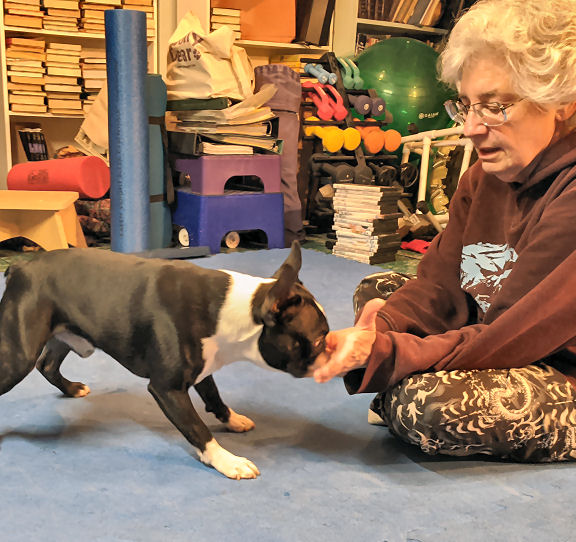Target training is one of those dog skills that gets more useful the longer you know it. When your dog will reliably go to a target and touch it, the possibilities are endless. You can bring your dog in close, or send them far away. If you play dog sports, like agility, it can even help your dog understand what bits of the obstacles they must touch.
If your dog already knows “Touch!” you’re a good chunk of the way to target training. Instead of your hand, the target is an object, like the lid of a plastic container, that can be easily moved. That way you can even teach your dog to go away from you. Achieving training at a distance is something many trainers aspire to. Target training your dog will help you get there.
Possibly the most useful part of target training is giving your dog something to do in a stressful situation. Let’s imagine you have to walk through a crowded area with your dog. If your dog will, reliably, stay focused on touching the target, you can sail through without problems. It sure beats having to worry about all the little things that might distract or upset your dog and cause them to react poorly.
Calming their nerves

All of the little focus games we play are meant to make life easier. Teaching your dog how to deal with stress, especially if you have an anxious dog, is important. Giving your dog something familiar, repetitive, and enjoyable to do helps with stress. Target training can also include an element of “find it,” and expands on the possibilities of “Touch!” where you’re always in reach.
The first thing to do is decide on a target object. It can be anything you choose, so think about where and when you might use it. We generally use plastic lids from assorted food products – cottage cheese, butter, sour cream. Ice cream lids work well, too. And provide a reason to buy ice cream.
While you’re choosing, think about the color of the item. It should be highly visible on whatever surface you tend to practice on. We have blue matting on the floor, so the white lids are a bright contrast.
First step
If you’ve been following 2-Minute-Trainer for any time, you’ll recognize the first part of the process. All you have to do is put the target on the floor, stare at it, and wait for your dog to do something. If your dog looks at it, or sniffs it, or licks it, put a treat on the target. Don’t feed the dog from your hand. Put it on the target. We want the dog to understand that good things happen on the target when they interact with it. If your aim is a nose touch, don’t reward the dog for pawing at the target. Likewise, if they pick it up in their mouth, no reward. Be specific about what you want. Reward only when you get it.
If you’re not in a position to reward (you have to go get more treats), be sure to pick up the target so the dog doesn’t have access. If they perform the behavior you want and don’t get rewarded (you weren’t there), the learning flow will be disrupted. The value of touching the target will diminish for every touch that doesn’t get rewarded.
On your merry way
Most dogs pick up on target training almost immediately. When you’re pretty sure that your dog understands the idea, move the target around. Will they follow it? If you hold it up, will they reach to touch it? What about if someone else places it across the room? Will they search for it and play hide and seek?
Target training can prove incredibly powerful. Hope’s French Bulldog girl Dax loved her targets. Their first-ever agility competition was held at an indoor soccer arena. Needless to say, there are all kinds of white circles painted in the turf in the venue. Dax had to go and touch each of them, sure there would be treat. It wasted a little time, but they did qualify and Dax was more relaxed, knowing she had a job to do.
If you are involved in any dog sports, you can use the target to teach your dog correct performance of several different exercises and obstacles. For agility, a target at the end of the dog walk teaches the dog to touch the entire down side. Likewise with the A-Frame. In Obedience, placed at the landing side of the Broad Jump, it teaches the dog to jump straight out before coming to “Front!”
Use it wherever
If you’re using the target as a training tool, teaching your dog where you want him to go, be sure it’s pre-baited with a treat or that someone will be nearby to reward immediately. If dogs don’t get rewarded for doing things right, there’s no reason for them to continue doing it. Once the dog learns the behavior, you can randomize and eventually eliminate the target, if you choose. If/when you do, be sure to maintain the rate of reward. The target was a tool to “explain” the behavior to the dog and your good dog deserves to be rewarded for it.

